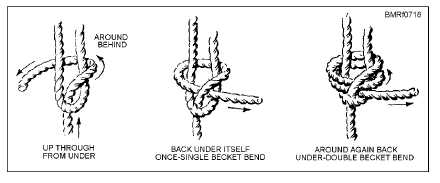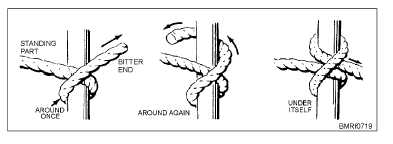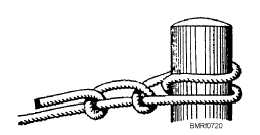3. Take another turn. (Notice that both turns go
around in the same direction.)
4. Pass the end under itself, and the hitch is
complete.
Another way to make this hitch is to form two
underhand loops. Lay the second loop on top of the first.
This method is the usual way to form the hitch when it
can be slipped over the end of the object to which the
line is to be secured.
Round Turn and Two Half Hitches
The chief advantage of the round turn and two half
hitches over other hitches is that it won’t slip along the
object to which it is secured. It’s made by taking a round
turn and making two half hitches (fig. 7-20). (The two
half hitches actually consist of a clove hitch taken
around the line itself.)
Making Up a Line
Once line is removed from the manufacturer’s coil,
or spool, it may be made up (for ready use) by coiling
down, faking down, or flemishing. Figure 7-21 shows
the methods of coiling, faking, and flemishing lines.
Descriptions of making up lines are shown below:
“Coiling down a line” means laying it up in circles,
roughly one on top of the other. Faking down a line is
laying it up in the same manner as for coiling down,
except that it is laid out in long, flat bights, one
alongside the other, instead of in round coils. The main
advantage of working with line that is faked down is that
it runs off more easily. To flemish down a line, start with
the bitter end, and lay on deck successive circles of line
in the manner of a clock spring with the bitter end in the
center. Right-laid line is laid down clockwise; left-laid
line is laid down counterclockwise.
7-17
Student Notes:
Figure 7-18.—Single- and double-becket bends.
Figure 7-19.—Tying a clove hitch.
Figure 7-20.—Round turn and two half hitches.





